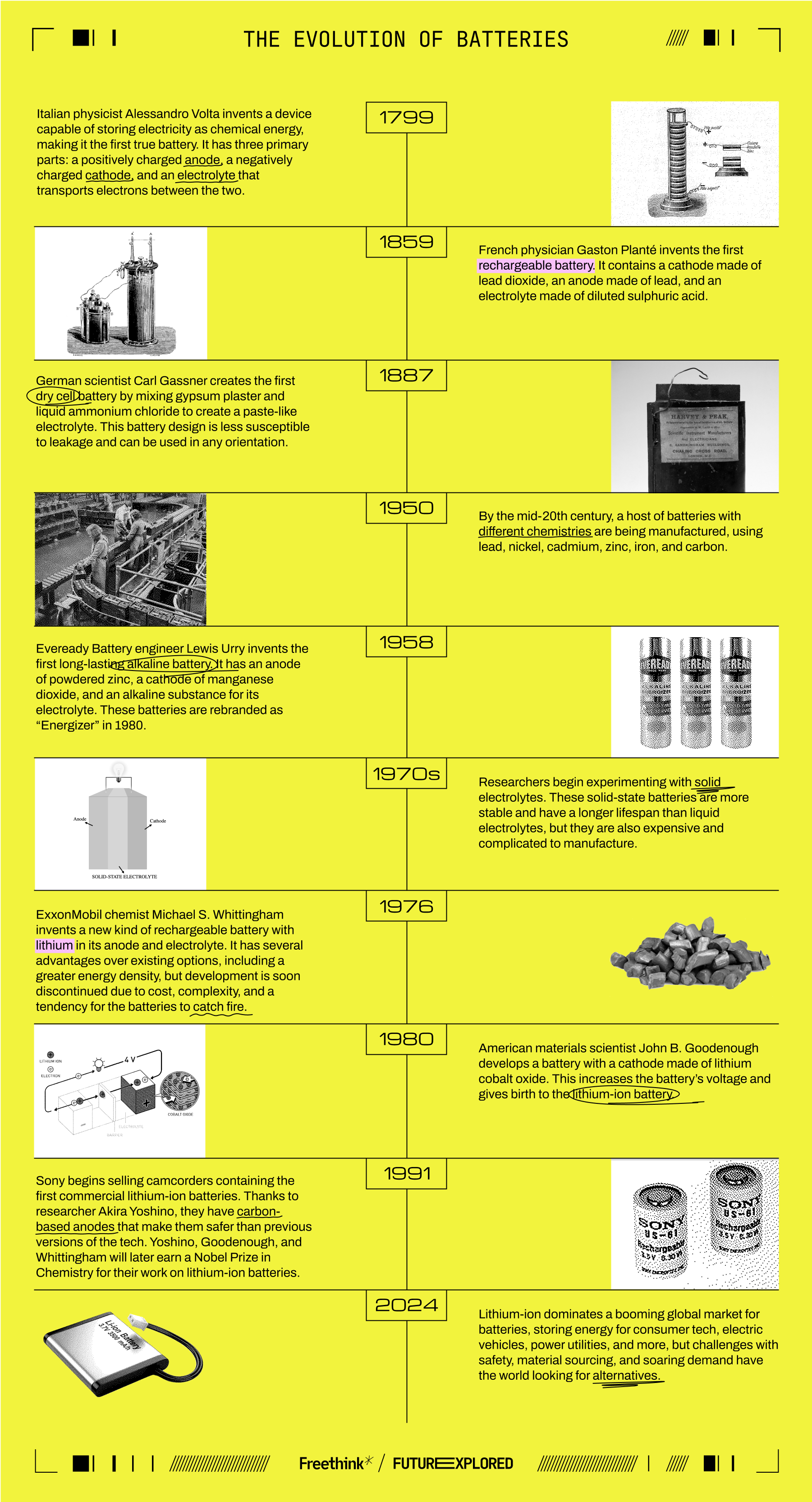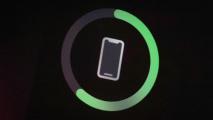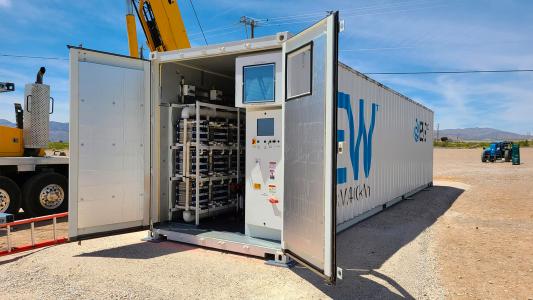This article is an installment of Future Explored, a weekly guide to world-changing technology. You can get stories like this one straight to your inbox every Saturday morning by subscribing here.
It’s 2030, and you just bought your first electric vehicle. You took the plunge because of the car’s solid-state battery — the same kind of energy-dense, ultra-safe battery also powering your smartphone and other tech devices. Millions of drivers will soon join you, drawn in by better range, lower fire risk, and lower cost.
Solid-state batteries
The discovery of electricity changed the world, giving birth to inventions that made our lives safer, healthier, more productive, and more enjoyable. Batteries took the discovery to the next level, giving us a way to store electricity and use it to power mobile devices.
Today, lithium-ion batteries dominate the battery market, but safer, higher capacity solid-state batteries could power the world of tomorrow — and maybe even help save us from the worst potential effects of climate change.
To find out how, let’s take a look at the history of batteries, the latest breakthroughs, and the trends suggesting that solid-state batteries could soon overtake lithium-ion ones.
Where we’ve been

Where we’re going (maybe)
Over the past 200 years, scientists have constantly innovated on batteries by building them with different materials, but the basic design hasn’t changed all that much since the first battery in 1799. You have an anode made of one material, a cathode made of another, and a liquid (or near-liquid) electrolyte.
Solid-state batteries have been the major exception, but despite being lauded for decades as the battery of the future — lighter, safer, stronger, and with greater energy density than lithium-ion — they’ve been held back by cost, manufacturing challenges, and a tendency to short circuit.
After decades of research, though, solid-state batteries seem ready to finally deliver on their promise — powering everything from the tiniest tech to entire buildings.
Starting small
A few small solid-state batteries are already being used in some clocks, watches, and medical implants, but a new breakthrough by electronics manufacturer TDK is about to supercharge this trend.
In June, the company announced that it had developed a new version of its CeraCharge solid-state battery that has an energy density of 1,000 watt-hours per liter — 100 times greater than its existing CeraCharge battery.
TDK hasn’t shared much about the proprietary technology used to make the battery, but has revealed that it features a lithium alloy anode and an oxide-based solid electrolyte that makes it “extremely safe.”
Because the new CeraCharge battery can hold vastly more power than its predecessor, it could lead to longer-lasting and/or smaller devices. It could also be a rechargeable alternative to coin-cell batteries (aka “watch batteries”), which have a high energy density but are single-use.
“We believe that by replacing the vast amount of primary batteries … with secondary batteries, we can contribute to reducing environmental impact,” Hiroshi Sato, section head of the Energy Units Development Department at TDK, told Freethink.
Initially, TDK envisions the new CeraCharge battery being used in wireless headphones, hearing aids, and smartwatches, but it could eventually be scaled up for use in larger devices, such as smartphones, if the company can figure out the manufacturing hurdles.
“There is a challenge that as the battery area increases, it becomes difficult to fabricate a uniform and high-density structure, leading to structural defects such as cracks and distortions,” said Sato.
“Regarding these challenges, we would like to first accumulate production and practical experience with small batteries and then explore the potential for larger ones,” he continued.
Hitting the road
The lithium-ion batteries used in most EVs today are much more affordable and more powerful than what was available just a couple decades ago, but their drawbacks are slowing the transition away from internal combustion engines.
Some people are hesitant to buy a car that takes hours to charge and might not have enough juice to get them long distances. The possibility that the battery can catch fire doesn’t help.
Solid-state batteries have long been considered a potentially better alternative for EVs, but we’ve yet to see an EV with one make it to the assembly line. That could change in the near future as major automakers around the world are investing heavily in the technology.
In 2023, Toyota announced that it was working with Japanese energy company Idemitsu Kosan to begin manufacturing solid-state EV batteries by 2027-2028, with mass production to follow after.
“Through repeated trial and error and by combining the material technologies of both companies, we have been able to develop a crack-resistant material that demonstrates high performance,” said Koji Sato, Toyota Motor Corporation’s president and CEO.
Mercedes-Benz, meanwhile, believes solid-state EV batteries could provide nearly double the range of lithium-ion ones. Its goal is to get them into production vehicles by 2030, and it partnered with battery developer ProLogium Technology in 2022 to develop EV-ready solid-state batteries.
In January 2024, ProLogium opened the world’s first giga-scale solid-state battery factory, and mass production is expected to begin in 2027. At full capacity, the factory will be able to make enough batteries for 26,000 EVs annually.
“After 17 years of dedicated effort, ProLogium is thrilled to present next-generation solid-state batteries to the world,” said Vincent Yang, ProLogium’s founder and CEO. “The time is now.”
Even more recently, Volkwagen’s battery company, PowerCo, struck a deal with battery developer QuantumScape that will allow it to use the company’s partially solid-state lithium-metal battery tech to manufacture enough batteries for up to one million EVs annually.
This tech features a solid electrolyte on one side of a ceramic separator and a liquid one on the other. According to QuantumScape, this approach helps avoid the formation of dendrites — spiky structures that can cause solid-state batteries to short circuit — while potentially increasing an EV’s range from 350 miles to 500 miles.
“With this cooperation, we aim to bring the most sustainable and cutting-edge battery cells to our customers,” said Frank Blome, CEO of PowerCo. “We have been collaborating and testing QuantumScape prototype cells for years now, and we are looking forward to bringing this technology of the future into series production.”
Supporting the grid
While solar and wind power are cheap, plentiful sources of energy, they’re also variable. To account for that, some power plants stash excess solar or wind power in battery energy storage systems (BESS) for use when the sun isn’t shining or the wind isn’t blowing.
Lithium-ion batteries are currently the standard for BESS, but solid-state batteries could be a better option due to their increased safety, longer lifespan, and higher energy density. First, though, we need to address the issues of cost and complex manufacturing for batteries at this size.
Dragonfly Energy is one of the companies trying to do this. In 2023, it obtained a patent for a manufacturing technique it says will help it overcome the challenge of manufacturing solid-state batteries for grid storage.
“[The technique] eliminates the need for large drying rooms, replacing methods which require a significant amount of time and expensive heavy machinery; making the process highly scalable within a reduced footprint, and allowing for increased production in a reduced time frame and at a lower cost,” writes Dragonfly.
Maryland-based battery maker Ion Storage Solutions, meanwhile, just opened a factory in April 2024 where it will make solid-state battery cells with ceramic electrolytes and lithium metal anodes for grid storage, EVs, and other applications. Its goal is to scale up to .5 GWh of capacity by 2028.
“From the outset, our goal has been to develop an advanced solid-state battery that delivers enhanced power, reliability, and safety, all while being scalable in production,” said CEO Ricky Hanna. “This new facility, one of the largest of its kind, marks a significant step towards realizing that vision.”
The big picture
While it’ll likely be several years before EVs equipped with solid-state batteries are driving off the lot — and maybe even longer before they’re helping shore up a clean electric grid — it’s encouraging to see this tech finally moving out of labs and into factories.
Just like with past battery designs, the first solid-state batteries to hit the market are unlikely to be the best possible versions of the tech, too.
In January, Harvard researchers unveiled a solid-state battery with silicon in the anode that can charge in 10 minutes, and just this week, Danish researchers reported that they’d developed a lithium-free solid-state battery made from minerals found in rocks.
“We have shown that we can find a material for a solid-state electrolyte that is cheap, efficient, eco-friendly, and scalable — and that even performs better than solid-state lithium-based electrolytes,” said researcher Mohamad Khoshkalam from the Technical University of Denmark.
As long as this innovation continues, we seem destined for a future in which solid-state batteries made from a variety of materials help make our tech devices last longer, our EVs drive farther, and our electric grids cleaner and more stable.
We’d love to hear from you! If you have a comment about this article or if you have a tip for a future Freethink story, please email us at [email protected].






